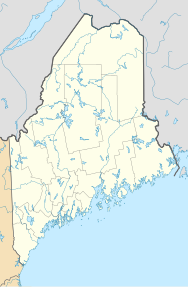Lyman, Maine
| Lyman, Maine | |
|---|---|
| Town | |
| Location within the state of Maine | |
| Coordinates: 43°30′20″N 70°38′21″W / 43.50556°N 70.63917°WCoordinates: 43°30′20″N 70°38′21″W / 43.50556°N 70.63917°W | |
| Country | United States |
| State | Maine |
| County | York |
| Incorporated | 1780 |
| Area | |
| • Total | 40.49 sq mi (104.87 km2) |
| • Land | 38.99 sq mi (100.98 km2) |
| • Water | 1.50 sq mi (3.88 km2) |
| Elevation | 272 ft (83 m) |
| Population (2010) | |
| • Total | 4,344 |
| • Estimate (2012) | 4,372 |
| • Density | 111.4/sq mi (43.0/km2) |
| Time zone | Eastern (EST) (UTC-5) |
| • Summer (DST) | EDT (UTC-4) |
| ZIP code | 04002 |
| Area code(s) | 207 |
| FIPS code | 23-41750 |
| GNIS feature ID | 0582572 |
| Website | www |
Lyman is a town in York County, Maine, United States. The population was 4,344 at the 2010 census. It is part of the Portland–South Portland–Biddeford, Maine metropolitan statistical area. Lyman, together with Alfred, is home to Massabesic Experimental Forest.
In 1660, John Sanders, John Bush and Peter Turbat purchased from the Abenaki sachem Sosowen and his son Fluellin what is now the township of Lyman. First called Swanfield, it was settled in 1767. While the original settlers are not known for certain, early records and deeds mention the following: William and Jacob Waterhouse (of Kennebunk), Love Roberts, Alexander Grant, Thomas Lord, Jacob Rhoades, Benjamin and Mark Goodwin (brothers who built one of the first mills at Goodwin's Mills), John Low (who served as town moderator and treasurer), John Burbank, Joseph Witten, James and William Brock, Mark Ricker, Robert Cousens, Valentine Hill, and Gershom Downs.
Swanfield would be incorporated by the Massachusetts General Court on April 24, 1780 as Coxhall, probably after Coggeshall (pronounced Coxhall) in Essex, England. On February 25, 1803, the name was changed to Lyman in honor of Theodore Lyman, a wealthy merchant who established a successful shipping firm in the 1790s at York before moving to Boston.
Farmers found the surface of the town moderately uneven, with fair soil that yielded good crops of grain, hay and apples. Watermills were established at the outlets of the larger ponds, with two sawmills at Swan Pond and another at Kennebunk Pond. Lumbering was a considerable source of income for many inhabitants. In 1782, a sawmill and gristmill were erected at Goodwin's Mills, which developed into the town's only business and trade center, despite the fact that some of the village is actually located in Dayton.The Great Fires of 1947 devastated part of Lyman. Today, the town is largely a bedroom community.
...
Wikipedia

